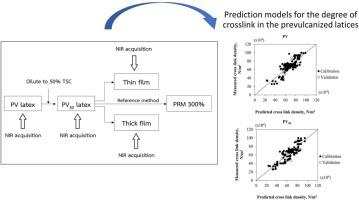Industrial Crops and Products ( IF 5.6 ) Pub Date : 2020-11-10 , DOI: 10.1016/j.indcrop.2020.113016 Chin Hock Lim , Panmanas Sirisomboon

|
The objective of this project is to use the four models to predict the crosslink densities based on reference method of PRM 300% using portable low-cost visible and shortwave near-infrared (Vis/SW-NIR) spectrometer across wavelengths of 350-1100 nm. The degrees of crosslink reflect on the properties of the prevulcanized (PV) latices and latex products produced and hence useful for quality control in the process of production. The four models were optimized using partial least squares regression (PLSR) that the spectra were collected from PV, PV50, thin and thick films. The use of thin and thick films was to emulate the latex products that used the PV latices. The results showed that there were almost no difference in the PV and PV50 models by the coefficient of determination (R2) and root mean square error of calibration (RMSEC) of 0.70 and 9.04 × 104 N/m2 and 0.75 and 8.59 × 104 N/m2, respectively. Among the four models, thin and thick film models had poor results indicated by the coefficient of determination (R2) and root mean square error of calibration (RMSEC) of 0.02 and 17.31 × 104 N/m2 and 0.05 and 16.63 × 104 N/m2, respectively. Based on these results, only the models of prevulcanized (PV) latices could be used for quality assessment. Hence the Vis/SW-NIR spectrometer could be a cheap alternative for crosslink density determination of PV latices and would be a beneficial tool for monitoring the process of vulcanization in the rubber industry.
中文翻译:

使用低成本近红外光谱仪测量预硫化天然橡胶胶乳和胶乳产品的交联密度
该项目的目的是使用这三种模型,基于便携式RMB可见光和短波近红外(Vis / SW-NIR)光谱仪,在350-1100 nm波长范围内,根据PRM 300%的参考方法预测交联密度。 。交联度反映了所生产的预硫化(PV)胶乳和乳胶产品的性能,因此可用于生产过程中的质量控制。使用偏最小二乘回归(PLSR)优化了这四个模型,该光谱是从PV,PV 50,薄膜和厚膜中收集的光谱。薄膜和厚膜的使用是为了模拟使用PV胶乳的乳胶产品。结果表明,PV和PV 50模型的测定系数几乎没有差异(R2)和校准的均方根误差(RMSEC)分别为0.70和9.04×10 4 N / m 2,以及0.75和8.59×10 4 N / m 2。在这四个模型中,薄膜模型和厚膜模型的结果差,分别由测定系数(R 2)和校准的均方根误差(RMSEC)分别为0.02和17.31×10 4 N / m 2以及0.05和16.63×10 4牛顿/米2, 分别。基于这些结果,只有预硫化(PV)胶乳模型可以用于质量评估。因此,Vis / SW-NIR光谱仪可能是测定PV胶乳的交联密度的一种廉价替代品,并且将是监测橡胶行业硫化过程的有益工具。











































 京公网安备 11010802027423号
京公网安备 11010802027423号